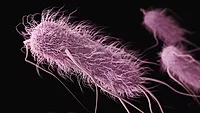Study Finds High Levels of AMR in E. coli in Chicken

A recent study published in Microbiology Insights has discovered high levels of antimicrobial resistance (AMR) in Escherichia coli isolated from samples of retail chicken meat and chicken fecal matter. The study was conducted in Ghana, where antibiotics are widely used—with minimal regulation—to meet the nation’s high demand for fresh chicken. The study contributes to the ongoing AMR surveillance efforts in the agrifood sector that are necessary to informing human medical and veterinary practices on how to approach the global health threat posed by AMR.
To conduct the study, researchers obtained 25 samples of raw chicken and 50 samples of poultry fecal matter from eight popular retail stores and two medium-scale farms, respectively. The selected retail stores sell imported chicken meat from Brazil, the U.S., and Belgium to both individuals and restaurants. The selected farms raise over 6,000 layers and broilers each; bring in day-old chicks and feed mills from other Ghanaian farms; maintain regular vaccination and drug administration programs; and sell eggs, dressed broilers, and live birds to both individuals and restaurants.
After isolating and identifying the E. coli strains found in the poultry samples, the researchers tested the isolated strains for antimicrobial susceptibility to 11 important antibiotics: ampicillin, cefotaxime, cefoxitin, ceftazidime, cefuroxime, chloramphenicol, ciprofloxacin, gentamicin, nalidixic acid, co-trimoxazole, and tetracycline. The study found that:
- For cefuroxime, ceftazidime, and cefotaxime, the AMR levels of E. coli isolates were less than 25 percent
- AMR to ciprofloxacin ranged from 12.5–53.6 percent
- AMR to cefoxitin ranged from 35.7–50 percent
- AMR levels to broad-spectrum antibiotics were high, with resistance to tetracycline ranging from 62.5–82.1 percent, ampicillin from 62.5–78.6 percent, and chloramphenicol from 37.5–46.4 percent
- E. coli isolates were up to 39.3 percent resistant to gentamicin
- Resistance to nalidixic acid and co-trimoxazole ranged from 50–53.6 percent and from 37.5–67.9 percent, respectively
- All E. coli bacteria isolated from raw chicken samples were susceptible to gentamicin and cefotaxime, as well as fairly susceptible to ceftazidime and cefuroxime, with resistance of 7.1 percent and 17.9 percent, respectively
- Fecal isolates were highly resistant to tetracycline (82.1 percent) and ampicillin (78.6 percent) in comparison to those of chicken meat samples, with resistance of 62.5 percent each
- Multidrug resistance of E. coli isolates derived from feces and chicken samples were 57.1 percent and 62.5 percent, respectively.
The overall prevalence of E. coli in fecal samples and chicken meat samples was 56 percent and 32 percent, respectively. Isolates were highly resistant to tetracycline, ampicillin, cotrimoxazole, and chloramphenicol, and were fairly susceptible to cefuroxime, ceftazidime, and cefotaxime. The varying levels of AMR in E. coli suggest that poultry environments are potential reservoirs for antibiotic-resistant genes that can spread from animals to human populations. The researchers suggest that future studies examine the detection of resistance genes in bacterial isolates from chicken, poultry environments, and humans to demonstrate the need for a “one health” approach when using antibiotics in poultry farming.
The researchers also note that the high levels of AMR in E. coli isolates from fecal matter samples are a public health concern because cross-contamination often occurs during slaughter and processing. Therefore, the researchers call for greater adherence to Hazard Analysis and Critical Control Points (HACCP) principles in chicken production to prevent the spread of resistant E. coli strains throughout the food chain.
Looking for quick answers on food safety topics?
Try Ask FSM, our new smart AI search tool.
Ask FSM →









